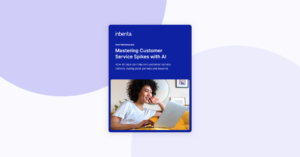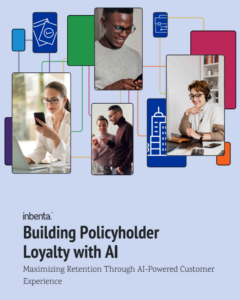Let’s face it. Traveling has been getting harder and harder since Covid came around.
First of all, you have tons of local restrictions that change every two weeks or even less, which makes it so hard for passengers to keep up with and comply with regulations.
Second, there are tons of cancellations due to surges in Covid cases, new safety laws, and other scenarios, all of it pushing travelers to cancel, reschedule or postpone their flights.
These situations call for superior airline customer service. Quality of attention needs to be higher than ever, but at the same time scalable enough to make it manageable with the uptick in customer support requests.
Achieving top-notch airline support with chatbots
Chatbots and virtual clerks can simplify customer care’s work and speed up resolution times while automating a huge amount of support answers.
In this article, we’ve collected 8 chatbot use cases to show you how conversational AI is automating airline support.
Automate flight search & bookings
When we’re looking for a flight, we tend to use a search engine and then scroll down through tens of results. Chatbots allow flight search & booking to be much more conversational and efficient. The user only needs to input the desired date and time and the chatbot will recommend the closest match.
Flight update notifications
Chatbots can send automated reminders and update notifications to users in order to inform them of status updates or changes regarding their flight or journey. This functionality creates a more direct and conversational channel, instead of sending the typical mail notification that sometimes gets buried under tons of other emails.
Upgrades or upselling management
Chatbots can be used as a sales upselling tool to suggest additional services, upgrades and offer upsell promotions to travelers who have already booked a flight. The idea behind that is that a chatbot can work as 24h virtual clerk and salesperson, automating follow-ups to increase the value of the traveler’s purchases in an automated way.
Baggage tracking and claims
Losing their bags is one of the top traveler’s concerns when flying. Many have experienced what it is to lose everything you bring with you—which quite often means everything you most frequently use. Baggage tracking systems have improved in the last few years. However, a chatbot can be used as a conversational channel to give passengers access to real-time information on baggage location and even help them file a baggage claim without the need to hop on a call with one of your agents, and being put on hold for 10 minutes.
Conversational check-ins
Back in 2015, around 50% of all flight check-ins happened through an agent or at the check-in desk, with 32% of travelers using online check-in (web or app). In 2021, tables have turned and online check-ins account for 50% of all the airline check-ins and only 27% happen at the counter. Chatbots offer a new online channel for check-in, with a more conversational interface that allows them to request check-in as they’d do on a counter, but on the go, and in a much faster way.
Special assistance requests
Over time, airlines have become much more inclusive and simplified the way customers can ask for special assistance or services. For instance, when traveling with a wheelchair, a person can ask priority boarding or skip queues just by making a request. However, some of these requests still take time and require the passenger to talk to a human agent, despite the airline having procedures in place for such cases. A chatbot can automate those requests and simplify both the airline agents’ tasks and the procedures a person usually needs to follow to obtain such services.
Flight payments or reimbursements
We all know the typical boring payment page that demands passengers to choose different options and mark checkboxes. But what if you could make that process conversational and transactional at the same time?
For instance, instead of requesting the user to add a piece of luggage by checking a box they might miss, you can simply use the chatbot to ask them if they want to check in some baggage and prompt them to click on ‘yes’ or ‘no’ buttons. This creates a closer, more personal experience including the payment point, which can also happen within the chatbot instance, simply by connecting it with webhooks to payment platforms.
Targeted personalized offers
Let’s say a family is flying with their children. Why not offer them additional support or services to make their journey easier? Airlines can automate this kind of process by means of chatbots to increase revenue and strengthen their customer relationship, increase loyalty and provide superior customer service.
Airline Chatbot Examples
During the past decade, airlines have gradually implemented customer self-service projects to allow travelers to access information 24/7 on their flights, bookings, mileage, and so on, avoid online waiting lines, and have an overall more enjoyable flying experience.
These include in many cases chatbots, but also other self-service tools like smart FAQ or help centers. Let’s see a couple of examples.
Volotea Chatbot & Help Section
Volotea is a southern European airline company operating in France, Italy, Spain, and Greece. It is a very good example of how a knowledge center can reduce customer support agents’ workload and increase customer satisfaction rates at the same time.
On the airlines’ website, we can see a Help section that offers both a searchable FAQ and a chatbot.
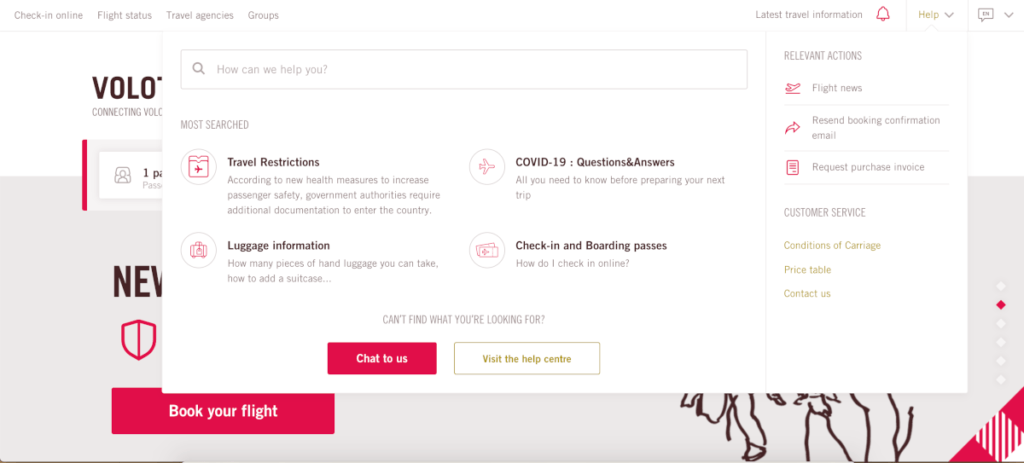
Their FAQ offers also suggestions as-you-type, thanks to predictive search functionality.
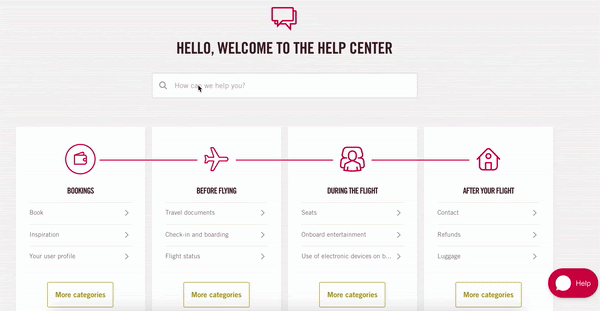
Their chatbot also provides a very good experience and answers relevant questions in an automated way in a matter of seconds.
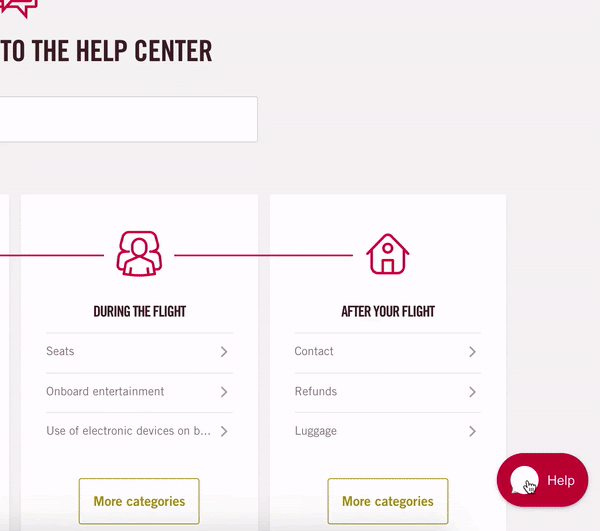
Gol Airlines
Gol is the top Brazilian airline and one of the most important airline companies in South America. Their chatbot, Gal, helps passengers book and modify their flights, check flight updates, and more.
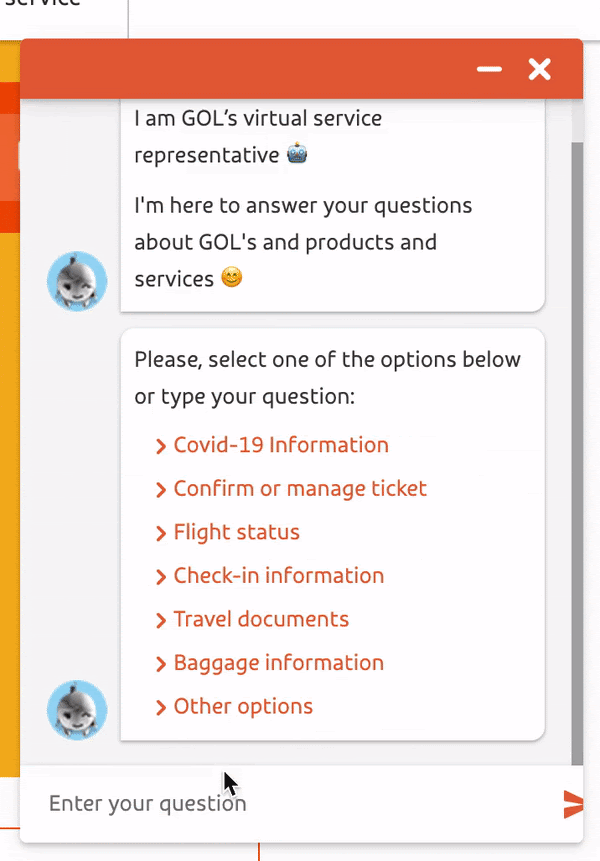
With Inbenta’s technology, they created not only their website chatbot, but they also automated their existing customer support service through Whatsapp, to let customers not only contact the airlines, but also enable check-in, booking management, or seat selection.
Today, approximately 35% of Gol customers finalize their check-in process through WhatsApp. You can listen below to the testimonial of Elisa Moreira, Customer Service Manager at GOL.
If you want to know more about their chatbot, make sure to check their case study.
Create Your Own Airline Chatbot
Creating a top-notch chatbot for your airline company is easy. Get started and build your own airline chatbot with Inbenta. Get access to:
- 60 preset travel contents you can use out-of-the-box
- Chatbot dialog manager to edit and control chatbot conversations
- Top NLP and symbolic AI technology
- Additional FAQ and semantic search capabilities



